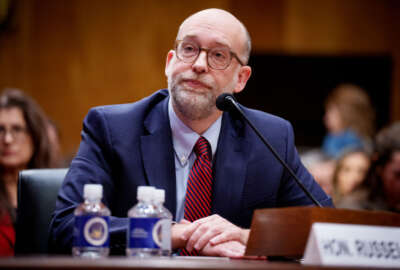With recent federal hiring changes, agencies see options to reduce burdens on HR staff
The traditional federal hiring system often places unneeded burdens on HR staff. Here’s how OMB and OPM are trying to shake up the way agencies are recruiting.
Shortly after launching a pair of major federal hiring updates this year, the Office of Management and Budget and the Office of Personnel Management are turning their efforts to help guide agencies as they work to put those changes into practice.
Recent guidance on the federal hiring experience, as well as finalized regulations for the Pathways Program, both aim to ease common burdens on HR professionals and federal job applicants, while adding flexibility to the often slow and cumbersome federal hiring process. In practice, reshaping federal recruitment will likely take years of work. But leaders at OPM and OMB said they are starting to see early signs of promising progress.
“I think that there’s a recognition, at least amongst the crowd of HR specialists, that the work that we’re trying to do is actually trying to improve their experience as well,” Kristy Daphnis, OMB’s acting deputy assistant director for performance and personnel management, said Wednesday during a panel hosted by the National Academy of Public Administration (NAPA). “The way that the system has been set up, it has, in some cases, added to their burden. But if you put in place better assessments, better sharing of candidates, you take some of the noise out of the system, that actually reduces their workload.”
So far, Daphnis said the response has been positive from HR specialists and hiring managers in reaction to the August 2024 joint memo on the federal hiring experience. The tools that OPM and OMB put in place to help agencies take on the new hiring guidance are in large part aiming to reduce workloads for the HR workforce.
Pooling both job announcements and candidate assessments for specific occupations — two items that can be reused across multiple agencies and through multiple hiring announcements — will be particularly helpful for reducing “friction” for the HR workforce, Daphnis said.
“If you can get hiring managers on a better path to being more informed about the process, that also reduces HR specialists’ workload,” Daphnis added.
Federal hiring memo sets the floor, not the ceiling
The hiring experience memo from OPM and OMB isn’t trying to reinvent the wheel, but rather collect many promising practices across agencies, and encourage implementation more broadly across government. The idea is to help more agencies adopt what has already worked well in certain cases, such as pooled hiring. Ultimately, the goal is to make the process easier from three different perspectives: hiring managers, HR specialists and job applicants.
“There’s not a lot of new stuff in there, but what we’re trying to do with this memo is catalog some of the existing tools that we’ve worked really hard to get out there to these various communities, to make sense of it, and create a bit of a user guide and a platform to bring it all together in in one place,” Daphnis said. “What we have in the guidance is really meant to set the floor and not the ceiling around how agencies are approaching this.”
On top of giving recommendations to agencies to address burdens and frustrations unique to each of the three impacted groups, the guidance additionally looks at making changes to more long-term strategic workforce planning. The guidance also points to specific metrics and data that should help agencies understand how they are making progress in adapting their recruitment strategies.
“We’re looking at things like, what do applicant satisfaction survey scores look like? What is the net number of external hires that we’re bringing in from the outside? What are the transfer rates in certain functional communities?” Daphnis said. “How are we actually doing on pooled hiring actions, and how are we doing on those types of actions that are across government, where multiple agencies are making selections?”
Though the memo has only been public for a couple of months, Daphnis said she has seen agencies already taking some early steps to try to change their recruitment processes.
“Making the job titles in the actual job announcements more understandable to individuals that are reading them, by simplifying the job titles, for example,” Daphnis said.
Pathways Program updates sparking “new interest”
In addition to the hiring experience guidance, agencies are also working to adjust their approach to early-career hiring this year, as a result of updated regulations for the Pathways Program — the government’s flagship program for recruiting younger generations of talent.
Latonia Page, OPM’s deputy associate director for talent acquisition, classification and veterans programs, said the new Pathways Program regulations, finalized in April 2024, are already starting to take root at agencies.
“One of the things that we found was that the release of the [Pathways] regulations really sparked new interest from hiring managers,” Page said Wednesday during the NAPA panel. “Agencies have really taken a look at their current policies and procedures, and they’ve been able to make changes that are reflective of where we are now with the workforce.”
After the new Pathways regulations became official in June, clearing the way for skills-based hiring, higher pay and eased requirements in early-career recruitment, agencies are now facing another Pathways deadline coming up in December. They’ll have to put a policy in place for using the Pathways Program under the new regulations. Previously, agencies had to establish a memorandum of understanding with OPM to be able to use the program.
Even after agencies get those policies in place in the coming months, Page said OPM will continue working with agencies to answer their questions and clarify how the regulations should look in practice, as agencies work to implement them.
“We meet with them on a monthly basis. We connect with them through the CHCO Council — there are a multitude of avenues that we have where we talk with them about how implementation is going,” Page said.
And on the applicant end of the program, Page said the regulations overhaul “has given us increased visibility with potential applicants for the Pathways Program.”
Copyright © 2025 Federal News Network. All rights reserved. This website is not intended for users located within the European Economic Area.
Drew Friedman is a workforce, pay and benefits reporter for Federal News Network.
Follow @dfriedmanWFED






